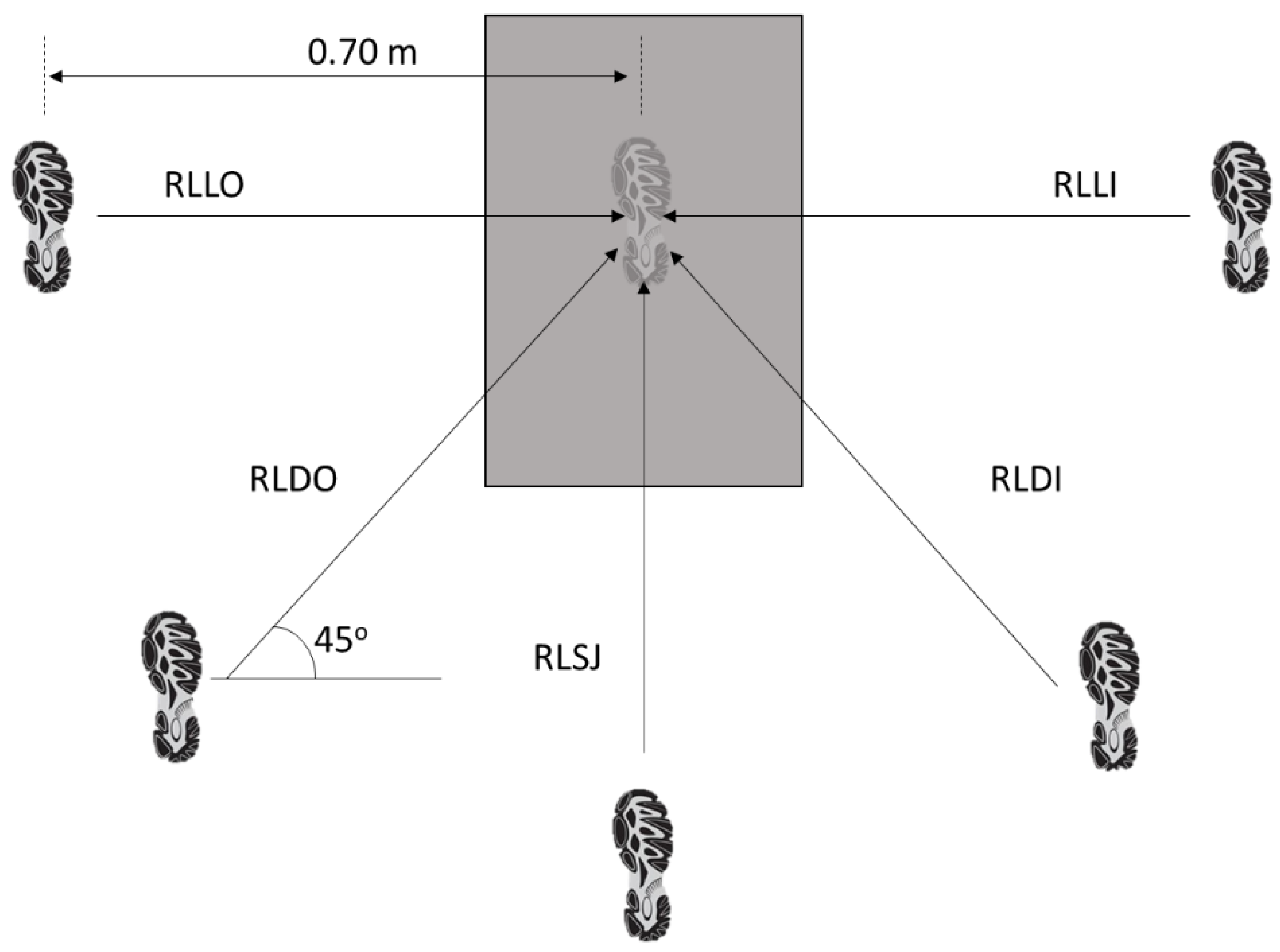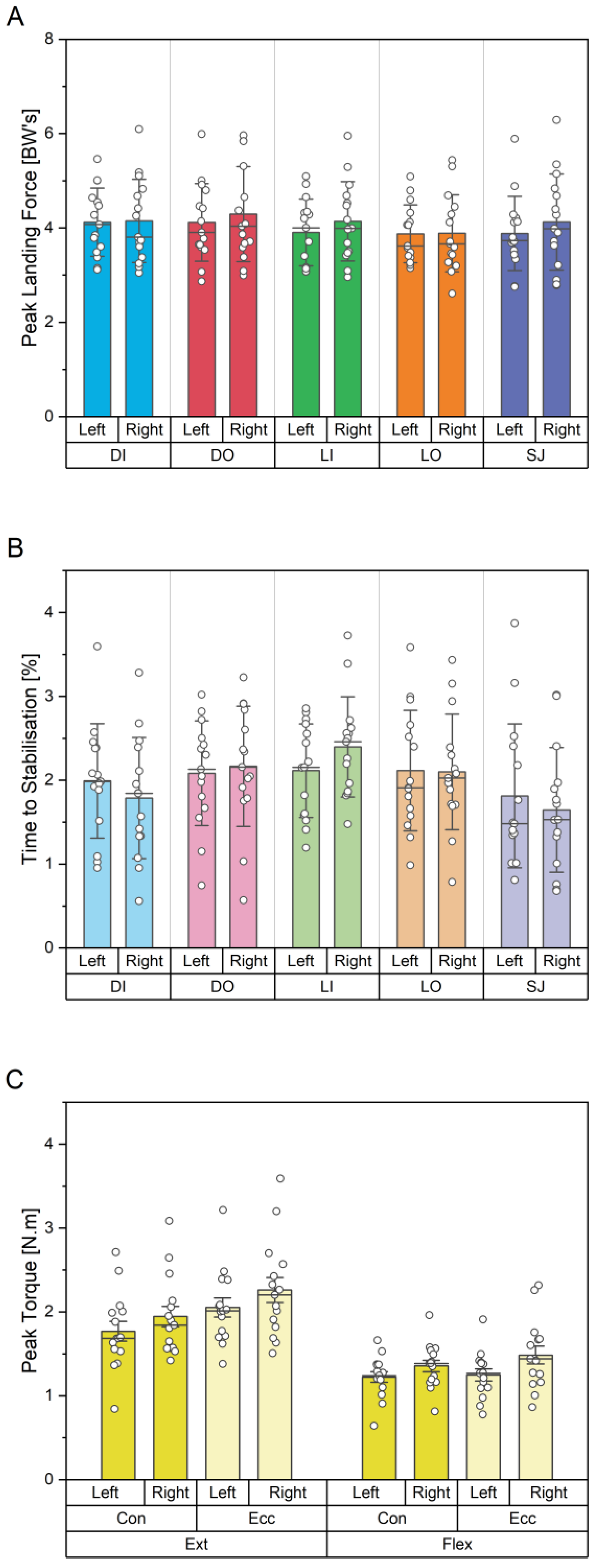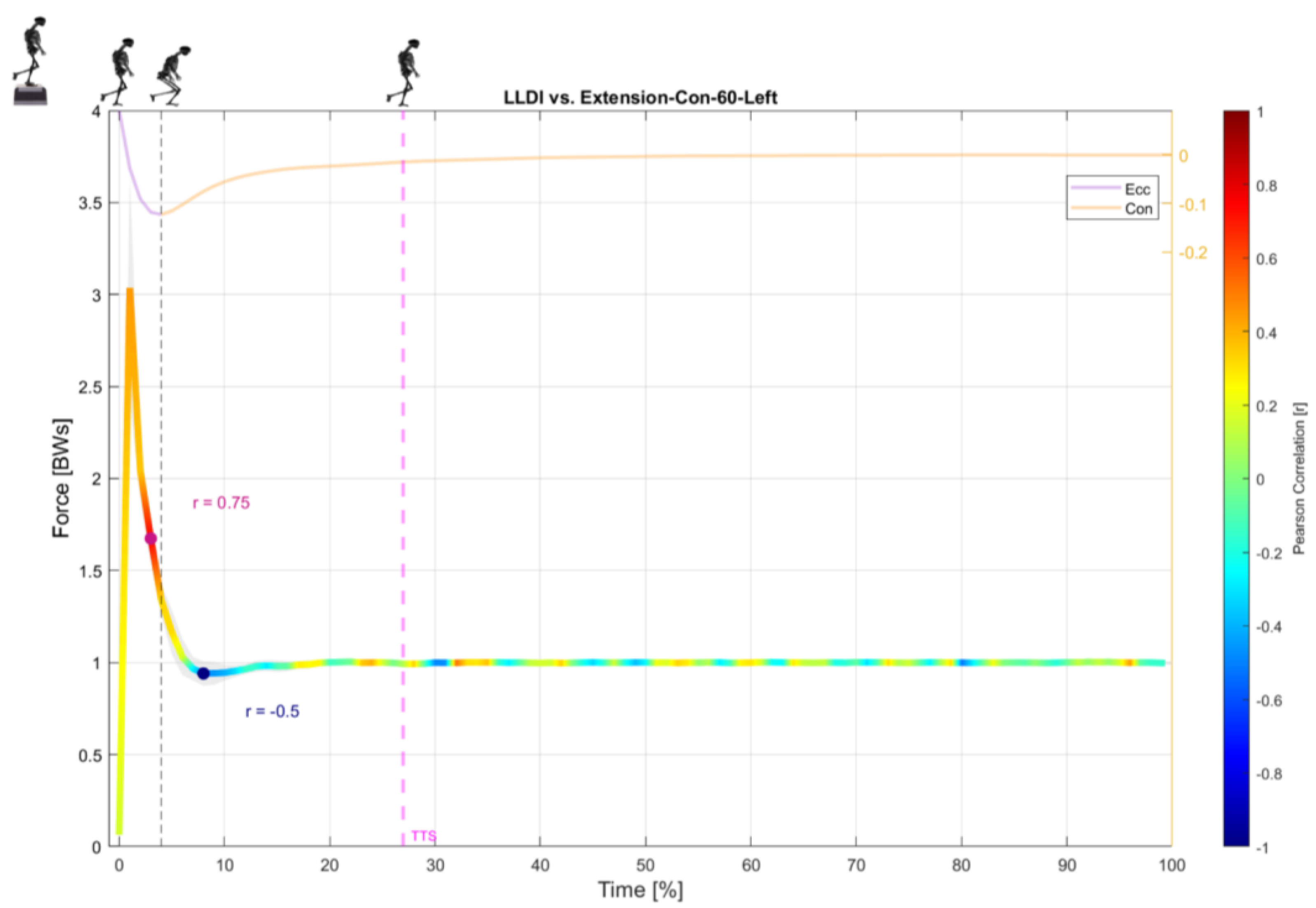Multidirectional Landing Kinetics, Stabilisation Times, and Associated Isokinetic Knee Torques of High-Level Female Netball Players
Abstract
:Featured Application
Abstract
1. Introduction
2. Materials and Methods
2.1. Participants
2.2. Experimental Design
2.3. Testing Procedures
2.4. Measurement Equipment and Data Analysis
2.5. Statistical Analyses
3. Results
4. Discussion
5. Conclusions
Supplementary Materials
Author Contributions
Funding
Institutional Review Board Statement
Informed Consent Statement
Data Availability Statement
Acknowledgments
Conflicts of Interest
References
- Pillay, T.; Frantz, J. Injury prevalence of netball players in South Africa: The need for injury prevention. S. Afr. J. Physiother. 2012, 68, 7–10. [Google Scholar] [CrossRef] [Green Version]
- Thomas, C.; Comfort, P.; Jones, P.A.; Dos’Santos, T. Strength and Conditioning for Netball: A Needs Analysis and Training Recommendations. Strength Cond. J. 2017, 39, 10–21. [Google Scholar] [CrossRef]
- Downs, C.; Snodgrass, S.J.; Weerasekara, I.; Valkenborghs, S.R.; Callister, R. Injuries in Netball-A Systematic Review. Sports Med.-Open 2021, 7, 3. [Google Scholar] [CrossRef] [PubMed]
- Hopper, D.; Elliott, B.; Lalor, J. A descriptive epidemiology of netball injuries during competition: A five year study. Br. J. Sports Med. 1995, 29, 223–228. [Google Scholar] [CrossRef] [Green Version]
- Fong, D.T.P.; Hong, Y.; Chan, L.K.; Yung, P.S.H.; Chan, K.M. A systematic review on ankle injury and ankle sprain in sports. Sports Med. 2007, 37, 73–94. [Google Scholar] [CrossRef] [Green Version]
- Collings, T.J.; Gorman, A.D.; Stuelcken, M.C.; Mellifont, D.B.; Sayers, M.G.L. Do the landing mechanics of experienced netball players differ from those of trained athletes competing in sports that do not require frequent landings? J. Sci. Med. Sport 2020, 23, 48–52. [Google Scholar] [CrossRef] [Green Version]
- Fox, A.S.; Spittle, M.; Otago, L.; Saunders, N. Descriptive analysis of landings during international netball competition: Enhancing ecological validity of laboratory testing environments. Int. J. Perform. Anal. Sport 2013, 13, 690–702. [Google Scholar] [CrossRef]
- Hopper, D.; Lo, S.K.; Kirkham, C.; Elliott, B. Landing patterns in netball: Analysis of an international game. Br. J. Sports Med. 1992, 26, 101–106. [Google Scholar] [CrossRef] [PubMed] [Green Version]
- Clark, N.C. Noncontact Knee Ligament Injury Prevention Screening in Netball: A Clinical Commentary with Clinical Practice Suggestions for Community-Level Players. Int. J. Sports Phys. Ther. 2021, 16, 911–929. [Google Scholar] [CrossRef]
- Meardon, S.; Klusendorf, A.; Kernozek, T. Influence of Injury on Dynamic Postural Control in Runners. Int. J. Sports Phys. Ther. 2016, 11, 366–377. [Google Scholar]
- Paterno, M.V.; Schmitt, L.C.; Ford, K.R.; Rauh, M.J.; Myer, G.D.; Huang, B.; Hewett, T.E. Biomechanical Measures during Landing and Postural Stability Predict Second Anterior Cruciate Ligament Injury after Anterior Cruciate Ligament Reconstruction and Return to Sport. Am. J. Sports Med. 2010, 38, 1968–1978. [Google Scholar] [CrossRef] [PubMed]
- Larwa, J.; Stoy, C.; Chafetz, R.S.; Boniello, M.; Franklin, C. Stiff landings, core stability, and dynamic knee valgus: A systematic review on documented anterior cruciate ligament ruptures in male and female athletes. Int. J. Environ. Res. Public Health 2021, 18, 3826. [Google Scholar] [CrossRef]
- Guo, L.; Zhang, J.; Wu, Y.; Li, L. Prediction of the Risk Factors of Knee Injury During Drop-Jump Landing with Core-related Measurements in Amature Basketball Players. Front. Bioeng. Biotechnol. 2021, 9, 738311. [Google Scholar] [CrossRef] [PubMed]
- Ross, S.E.; Guskiewicz, K.M. Effect of coordination training with and without stochastic resonance stimulation on dynamic postural stability of subjects with functional ankle instability and subjects with stable ankles. Clin. J. Sport Med. 2006, 16, 323–328. [Google Scholar] [CrossRef] [PubMed]
- Ross, S.E.; Guskiewicz, K.M.; Gross, M.T.; Yu, B. Balance measures for discriminating between functionally unstable and stable ankles. Med. Sci. Sports Exerc. 2009, 41, 399–407. [Google Scholar] [CrossRef]
- Bernier, J.N.; Perrin, D.H. Effect of coordination training on proprioception of the functionally unstable ankle. J. Orthop. Sports Phys. Ther. 1998, 27, 264–275. [Google Scholar] [CrossRef] [Green Version]
- Webster, K.A.; Gribble, P.A. Time to stabilization of anterior cruciate ligament-reconstructed versus healthy knees in nationalcollegiate athletic association division I female athletes. J. Athl. Train. 2010, 45, 580–585. [Google Scholar] [CrossRef] [Green Version]
- Colby, S.M.; Hintermeister, R.A.; Torry, M.R.; Steadman, J.R. Lower limb stability with ACL impairment. J. Orthop. Sports Phys. Ther. 1999, 29, 444–454. [Google Scholar] [CrossRef]
- Fransz, D.P.; Huurnink, A.; De Boode, V.A.; Kingma, I.; Van Dieën, J.H. Time to stabilization in single leg drop jump landings: An examination of calculation methods and assessment of differences in sample rate, filter settings and trial length on outcome values. Gait Posture 2015, 41, 63–69. [Google Scholar] [CrossRef] [Green Version]
- Cinarli, F.S.; Adanur, O.; Esen, O.; Barasinska, M.; Cepicka, L.; Gabrys, T.; Karayigit, R. Relationship between Unilateral Leg Extension Strength and Dynamic Balance in Healthy Young Men. Appl. Sci. 2022, 12, 8985. [Google Scholar] [CrossRef]
- Soylu, Ç.; Altundağ, E.; Akarçeşme, C.; Yildirim, N.Ü. The relationship between isokinetic knee flexion and extension muscle strength, jump performance, dynamic balance and injury risk in female volleyball players. J. Hum. Sport Exerc. 2020, 15, 502–514. [Google Scholar] [CrossRef]
- Mothersole, G.A.; Cronin, J.B.; Harris, N.K. Key prerequisite factors influencing landing forces in netball. Strength Cond. J. 2013, 35, 47–54. [Google Scholar] [CrossRef]
- Faul, F.; Erdfelder, E.; Lang, A.-G.; Buchner, A. G*Power 3, A flexible statistical power analysis program for the social, behavioral, and biomedical sciences. Behav. Res. Methods 2007, 39, 175–191. [Google Scholar] [CrossRef]
- Ebben, W.; van der Zanden, T.; Wurm, B.J.; Petushek, E.J. Evaluating plyometric exercises using time to stabilization. J. Strength Cond. Res. 2010, 24, 300–306. [Google Scholar] [CrossRef]
- Foster, C.; Hector, L.L.; Welsh, R.; Schrager, M.; Green, M.A.; Snyder, A.C. Effects of specific versus cross-training on running performance. Eur. J. Appl. Physiol. Occup. Physiol. 1995, 70, 367–372. [Google Scholar] [CrossRef]
- Lategan, L. Differences in knee flexion and extension angles of peak torque between men and women. Isokinet. Exerc. Sci. 2012, 20, 71–76. [Google Scholar] [CrossRef]
- Duvigneaud, N.; Bernard, E.; Stevens, V.; Witvrouw, E.; Van Tiggelen, D. Isokinetic assessment of patellofemoral pain syndrome: A prospective study in female recruits. Isokinet. Exerc. Sci. 2008, 16, 213–219. [Google Scholar] [CrossRef]
- Dufek, J.S.; Bates, B.T. The evaluation and prediction of impact forces during landings. Med. Sci. Sports Exerc. 1990, 22, 370–377. [Google Scholar] [CrossRef]
- Azevedo, A.M.; Oliveira, R.; Vaz, J.R.; Cortes, N. Professional Dancers Distinct Biomechanical Pattern during Multidirectional Landings. Med. Sci. Sports Exerc. 2019, 51, 539–547. [Google Scholar] [CrossRef]
- Kadri, M.A.; Noé, F.; Maitre, J.; Maffulli, N.; Paillard, T. Effects of Limb Dominance on Postural Balance in Sportsmen Practicing Symmetric and Asymmetric Sports: A Pilot Study. Symmetry 2021, 13, 2199. [Google Scholar] [CrossRef]
- Grozier, C.D.; Cagle, G.K.; Pantone, L.; Rank, K.B.; Wilson, S.J.; Harry, J.R.; Seals, S.; Simpson, J.D. Effects of medial longitudinal arch flexibility on propulsion kinetics during drop vertical jumps. J. Biomech. 2021, 118, 110322. [Google Scholar] [CrossRef]
- Harry, J.R.; Krzyszkowski, J.; Chowning, L.D.; Kipp, K. Phase-specific force and time predictors of standing long jump distance. J. Appl. Biomech. 2021, 37, 400–407. [Google Scholar] [CrossRef]
- Ross, S.E.; Guskiewicz, K.M.; Yu, B. Single-leg jump-landing stabilization times in subjects with functionally unstable ankles. J. Athl. Train. 2005, 40, 298–304. [Google Scholar]
- Prion, S.; Haerling, K.A. Making Sense of Methods and Measurement: Spearman-Rho Ranked-Order Correlation Coefficient. Clin. Simul. Nurs. 2014, 10, 535–536. [Google Scholar] [CrossRef]
- Schober, P.; Schwarte, L.A. Correlation coefficients: Appropriate use and interpretation. Anesth. Analg. 2018, 126, 1763–1768. [Google Scholar] [CrossRef]
- Pataky, T.C. One-dimensional statistical parametric mapping in Python. Comput. Methods Biomech. Biomed. Eng. 2012, 15, 295–301. [Google Scholar] [CrossRef]
- Pataky, T.C. Generalized n-dimensional biomechanical field analysis using statistical parametric mapping. J. Biomech. 2010, 43, 1976–1982. [Google Scholar] [CrossRef]
- Brooks, E.R.; Benson, A.C.; Fox, A.S.; Bruce, L.M. Physical movement demands of elite-level netball match-play as measured by an indoor positioning system. J. Sports Sci. 2020, 38, 1488–1495. [Google Scholar] [CrossRef]
- Ali, N.; Robertson, D.G.E.; Rouhi, G. Sagittal plane body kinematics and kinetics during single-leg landing from increasing vertical heights and horizontal distances: Implications for risk of non-contact ACL injury. Knee 2014, 21, 38–46. [Google Scholar] [CrossRef]
- Wang, L.I.; Peng, H.T. Biomechanical comparisons of single- and double-legged drop jumps with changes in drop height. Int. J. Sports Med. 2014, 35, 522–527. [Google Scholar] [CrossRef]
- Xaverova, Z.; Dirnberger, J.; Lehnert, M.; Belka, J.; Wagner, H.; Orechovska, K. Isokinetic Strength Profile of Elite Female Handball Players. J. Hum. Kinet. 2015, 49, 257–266. [Google Scholar] [CrossRef] [PubMed] [Green Version]
- Duvenage, K.-K.; Willemse, Y.; De Ridder, J.H. Bilateral Differences in Anthropometric Measurements and Isokinetic Strength Variables of Female University Netball Players. JPFMTS 2021, 9, 555752. [Google Scholar] [CrossRef]
- Vargas, V.Z.; Motta, C.; Peres, B.; Vancini, R.L.; Andre Barbosa De Lira, C.; Andrade, M.S. Knee isokinetic muscle strength and balance ratio in female soccer players of different age groups: A cross-sectional study. Physician Sportsmed. 2020, 48, 105–109. [Google Scholar] [CrossRef] [PubMed]
- Louw, Q.; Grimmer, K. Biomechanical factors associated with the risk of knee injury when landing from a jump. S. Afr. J. Sports Med. 2006, 18, 18–23. [Google Scholar] [CrossRef] [Green Version]
- Brown, C.; Ross, S.; Mynark, R.; Guskiewicz, K. Assessing Functional Ankle Instability with Joint Position Sense, Time to Stabilization, and Electromyography. J. Sport Rehabil. 2004, 13, 122–134. [Google Scholar] [CrossRef]
- Saad, T.; Davies, L.; Smith, M. Implementation of an injury prevention programme in community netball: An observational study. J. Sports Sci. 2021, 39, 2180–2188. [Google Scholar] [CrossRef]
- Gamble, P. Physical Preparation for Netball-Part 2, Approaching Programme Design; UK Strength & Conditioning Association: Lytham St. Anne’s, UK, 2011; pp. 13–21. [Google Scholar]
- Whitehead, S.; Weakley, J.; Cormack, S.; Alfano, H.; Kerss, J.; Mooney, M.; Jones, B. The Applied Sports Science and Medicine of Netball: A Systematic Scoping Review. Sports Med. 2021, 51, 1715–1731. [Google Scholar] [CrossRef]
- Kotsifaki, A.; Whiteley, R.; Van Rossom, S.; Korakakis, V.; Bahr, R.; Sideris, V.; Graham-Smith, P.; Jonkers, I. Single leg hop for distance symmetry masks lower limb biomechanics: Time to discuss hop distance as decision criterion for return to sport after ACL reconstruction? Br. J. Sports Med. 2021, 56, 249–256. [Google Scholar] [CrossRef]
- Kotsifaki, A.; Korakakis, V.; Graham-Smith, P.; Sideris, V.; Whiteley, R. Vertical and Horizontal Hop Performance: Contributions of the Hip, Knee, and Ankle. Sports Health 2021, 13, 128–135. [Google Scholar] [CrossRef]
- Fitzgerald, G.K.; Lephart, S.M.; Hwang, J.H.; Wainner, M.R.S. Hop Tests as Predictors of Dynamic Knee Stability. J. Orthop. Sports Phys. Ther. 2001, 31, 588–597. [Google Scholar] [CrossRef] [Green Version]
- Petschnig, R.; Baron, R.; Albrecht, M. The Relationship Between Isokinetic Quadriceps Strength Test and Hop Tests for Distance and One-Legged Vertical Jump Test Following Anterior Cruciate Ligament Reconstruction. J. Orthop. Sports Phys. Ther. 1998, 28, 23–31. [Google Scholar] [CrossRef] [PubMed]




| Sum of Squares | df | Mean Square | F | p | η2p | |
|---|---|---|---|---|---|---|
| Leg | 2584.10 | 1 | 2584.10 | 8.92 | 0.010 | 0.39 |
| Residual | 4055.20 | 14 | 289.70 | |||
| Contraction | 2891.10 | 1 | 2891.10 | 8.44 | 0.012 | 0.38 |
| Residual | 4796.20 | 14 | 342.60 | |||
| Leg * Contraction | 48.00 | 1 | 48.00 | 0.51 | 0.488 | 0.04 |
| Residual | 1325.10 | 14 | 94.60 |
| Peak Landing Force | Sum of Squares | df | Mean Square | F | p | η2p |
| Leg | 0.72 | 1 | 0.72 | 3.49 | 0.083 | 0.20 |
| Residual | 2.89 | 14 | 0.21 | |||
| Direction | 1.89 | 4 | 0.47 | 3.14 | 0.021 | 0.18 |
| Residual | 8.39 | 56 | 0.15 | |||
| Leg * Direction | 0.38 | 4 | 0.09 | 2.99 | 0.026 | 0.18 |
| Residual | 1.76 | 56 | 0.03 | |||
| Time to Stabilisation | Sum of Squares | df | Mean Square | F | p | η2p |
| Leg | 0.00 | 1 | 0.00 | 0.00 | 0.966 | <0.01 |
| Residual | 6.27 | 14 | 0.45 | |||
| Direction | 5.26 | 4 | 1.31 | 3.33 | 0.016 | 0.19 |
| Residual | 22.08 | 56 | 0.39 | |||
| Leg * Direction | 1.17 | 4 | 0.29 | 1.11 | 0.363 | 0.07 |
| Residual | 14.87 | 56 | 0.27 |
Disclaimer/Publisher’s Note: The statements, opinions and data contained in all publications are solely those of the individual author(s) and contributor(s) and not of MDPI and/or the editor(s). MDPI and/or the editor(s) disclaim responsibility for any injury to people or property resulting from any ideas, methods, instructions or products referred to in the content. |
© 2023 by the authors. Licensee MDPI, Basel, Switzerland. This article is an open access article distributed under the terms and conditions of the Creative Commons Attribution (CC BY) license (https://creativecommons.org/licenses/by/4.0/).
Share and Cite
Kamffer, L.; Hammill, H.V.; Willemse, Y.; Kramer, M. Multidirectional Landing Kinetics, Stabilisation Times, and Associated Isokinetic Knee Torques of High-Level Female Netball Players. Appl. Sci. 2023, 13, 1261. https://doi.org/10.3390/app13031261
Kamffer L, Hammill HV, Willemse Y, Kramer M. Multidirectional Landing Kinetics, Stabilisation Times, and Associated Isokinetic Knee Torques of High-Level Female Netball Players. Applied Sciences. 2023; 13(3):1261. https://doi.org/10.3390/app13031261
Chicago/Turabian StyleKamffer, Lenthea, Henriette V. Hammill, Yolandi Willemse, and Mark Kramer. 2023. "Multidirectional Landing Kinetics, Stabilisation Times, and Associated Isokinetic Knee Torques of High-Level Female Netball Players" Applied Sciences 13, no. 3: 1261. https://doi.org/10.3390/app13031261






